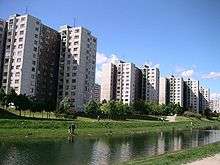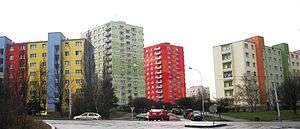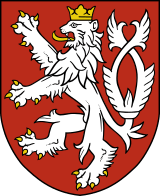Panelák
Panelák (Czech: [ˈpanɛlaːk]) is a colloquial term in Czech and Slovak for a panel building constructed of pre-fabricated, pre-stressed concrete, such as those extant in the former Czechoslovakia and elsewhere in the world. Paneláks are usually located in housing estates (Czech: sídliště, Slovak: sídlisko).

Panelák [plural: paneláky] is derived from the standard Czech: panelový dům or Slovak: panelový dom meaning, literally, "panel house / prefabricated-sections house". The term panelák is used mainly for the elongate blocks with more sections with separate entrances – simple panel tower blocks are called "věžový dům" (tower house) or colloquially "věžák". The buildings remain a towering, highly visible reminder of the communist era. The term panelák refers specifically to buildings in the former Czechoslovakia. However, similar buildings were built in other communist countries and even in the West.
History
Paneláks resulted from two main factors: the postwar housing shortage and the ideology of Czechoslovak leaders. Planners from the communist era wanted to provide large quantities of fast and affordable housing and to slash costs by employing uniform designs over the whole country. They also sought to foster a "collectivistic nature" in the people. In case of war, these houses would not be as susceptible to firebombing as traditional, densely packed buildings.
Between 1959 and 1995, paneláks containing 1.17 million flats were built in what is now the Czech Republic. They house about 3.5 million people, or about one-third of the country's population.
In Prague and other large cities, most paneláks were built in a type of housing estate known as a sídliště. Such housing developments now dominate large parts of Prague, Bratislava and other towns. The first sídliště built in Prague was Petřiny in the 1950s; the largest in Prague is Jižní Město (about 100,000 inhabitants), with 200 buildings built since the 1970s.
The largest concentration of paneláks in the former Czechoslovakia and central Europe can be found in Petržalka (population about 105,000), a section of the Slovak capital of Bratislava.
The city of Most is known for having a dominant share of people living in paneláks (approx. 80%). The historical city was torn down due to the spread of coal mining and the majority of its population was moved into paneláks.
Characteristics

In comparison to pre-war apartment buildings, paneláks can be truly enormous. Some are more than 100 metres long, and some are more than 20 stories high. Some even have openings for cars and pedestrians to pass through, lest they have to go all the way around the building.
Many people criticize paneláks for their low design quality, mind-numbing appearance, second-rate construction materials and shoddy construction practices. In 1990, Václav Havel, then president of Czechoslovakia, called paneláks "undignified rabbit pens, slated for liquidation." Panelák housing estates as a whole are said to be mere bedroom communities with few conveniences and even less character. However, paneláks are not universally detested. Some panelák housing estates were designed by Czech architects who aspired to follow the tradition of pre-war Czech modern architecture, notably functionalism. Despite unfortunate cost-saving changes during construction, some of those panelák estates do not fit the critique above.
Some housing estates do have other facilities, such as shopping centres, schools, libraries, swimming pools, cinemas and such. Also, architects sometimes made an effort to make the buildings distinct, by mixing various types of panelaks, for example, or by using different colours. Well-designed housing estates also have some environmental advantages. By leaving wide spaces between buildings, designers created large green spaces and parks, which are lacking in many prewar Czech neighbourhoods. In some places, paneláks were an improvement in sanitary conditions.
Paneláks today
Paneláks today remain in use by a mix of social classes.[1] People living in paneláks can usually either own their apartment or rent them, usually through a private landlord.
A home magazine, Panel Plus, is aimed at the millions of panelák-dwellers.
Housings estates (paneláks), especially in big cities, are often first targets for builders of telecommunication networks, as the housing estates combine a high concentration of people with easy access to underground and in-house spaces for cables. Panelák housing estates are usually the first neighbourhoods with access to cable TV, WiFi network coverage, cable-modem service, DSL and other telecommunication services.
Many panelák flats are now the property of their inhabitants and buildings can and are managed by housing cooperatives, authorities, municipalities, self-governing non-profit organizations and/or through public-private partnership.
The cost of replacing of paneláks in the short term would be well beyond the means of the Czech Republic or Slovakia. Nonetheless, the decay of many paneláks remains a serious problem requiring the attention of authorities in both countries.
Many Czech sociologists have expressed concern about the social development of panelák housing estates. The most endangered would be those lacking facilities other than "sleeping blocks" and with a bad connection to business and commercial centres. Some people fear that with the growth and deregulation of the housing market, the middle class may flee to other locations, and such panelák estates may become refuges for the poor or ghettos, although there is already a lot of poor people from lower social classes living in paneláks, generally because the rent is cheaper.
Some local authorities are making significant efforts to prevent this scenario by changing bedroom communities into multifunctional urban neighbourhoods. This may include support for the construction of missing facilities, such as shopping centres, churches, or improved transport accessibility.
Other countries
Buildings similar to paneláks were built also in other communist countries, and they are a common feature of cityscapes across Central and Eastern Europe, and to some degree Northern Europe.
One of the most drastic reconstruction policies of the Eastern Bloc was the systematization programme that took place in the 1970s and 1980s under Nicolae Ceaușescu in Romania. In 1971 Ceaușescu visited North Korea and was impressed by the Juche ideology. He enacted a mass programme of demolition and reconstruction of existing villages, towns, and cities, in whole or in part, in order to build blocks of flats (blocuri).
In Bulgaria, buildings similar to paneláks are colloquially known as "panelki", and are the predominant type of en masse housing throughout the country. In Hungary, these buildings are called panelház. In Poland, they are called "bloki" (blocks) or "wielka płyta" (the great panel). In Germany they are known as Plattenbau. Most buildings in Soviet-era Microdistricts are panel buildings.
In the European Union, among former communist countries, a majority of the population lives in flats in Latvia (65.1%), Estonia (63.8%), Lithuania (58.4%), Czech Republic (52.8%) and Slovakia (50.3%) (as of 2014, data from Eurostat).[2] However, not all flat dwellers in Eastern Europe live in communist era blocks of flats; many live in buildings constructed after the fall of communism, and some in buildings surviving from the era before communism.
In the United States, some housing estates have buildings that are similar or actually are paneláks, or they are build from the same or similar material.
Popular culture
- The movie Panelstory from Vera Chytilova shows the life of several inhabitants in a real unfinished communist-bloc apartment project. Awarded a Great Prize in San Remo in 1980.
- Béla Tarr's film Panelkapcsolat tells a doomed love story set in a similar housing project in Hungary. Special Mention at the 1982 Locarno Film Festival.
- Polish director Krzysztof Kieślowski's celebrated Dekalog series is set in a wielka płyta housing estate in Warsaw, Poland.
See also
| Wikimedia Commons has media related to Plattenbau. |
- Sídlisko (Slovakia)
- Brutalist architecture
- Minimalism
- Million Programme (Sweden)
- Housing estate
- Public housing
- Affordable housing
- Subsidized housing
- Subsidized housing in the United States
- Section 8 (USA)
- Plattenbau (Germany)
- Panelház (Hungary)
- Khrushchyovka (Former Soviet Union)
References
- Bibliography
- Stankova, Jaroslava, et al. (1992) Prague: Eleven Centuries of Architecture. Prague: PAV. ISBN 80-900003-1-2.
- Zarecor, Kimberly Elman (2011) Manufacturing a Socialist Modernity: Housing in Czechoslovakia, 1945–1960. Pittsburgh: University of Pittsburgh Press. ISBN 0-8229-4404-9.
- Reynolds, Matt (10 March 2005). Still Standing The Prague Post.
- Chánov case study
- Notes
- iHNed.cz. "Zachrante nase panelaky, tlaci na EU Cesko". ihned.cz/ (in Czech). Archived from the original on 2006-08-22. Retrieved 2020-05-16.
- see section Source data for tables and figures, Housing statistics: tables and figures



